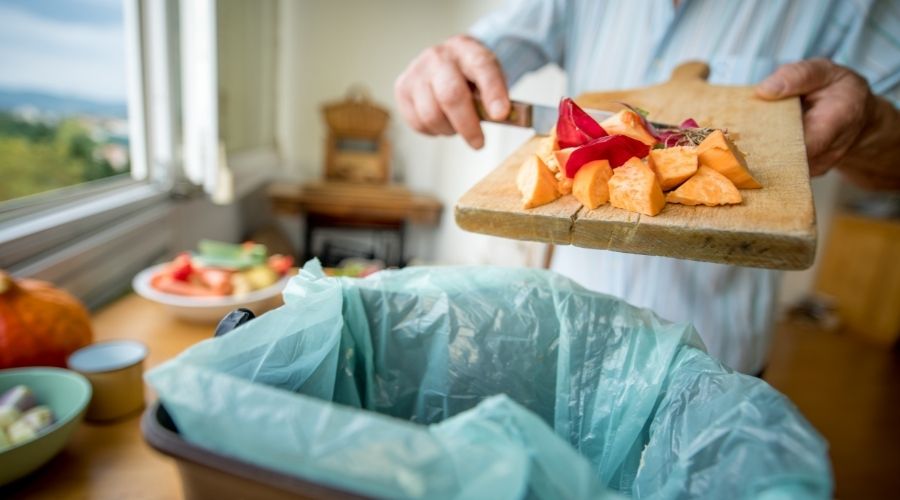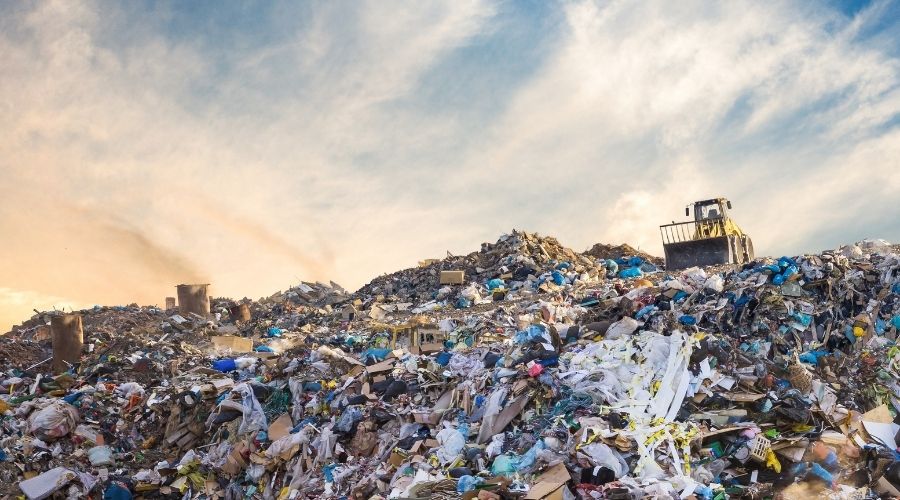
Food waste is one of the biggest problems facing humanity today. Between 33-50% of all food produced globally ends up in the trash. This food is valued at over $1 trillion.
The sad part is that 800 million people go to bed hungry every night. That is 1 in 9 people in the world who are starving or malnourished. Even sadder is that a quarter of the food wasted in the USA, UK, and Europe yearly could be enough to feed these people.
Here are a few more reasons why food loss is a problem and suggestions on how to reduce food waste.
What is Food Waste and Why is it a Problem?
Food waste occurs when edible food goes uneaten in homes, restaurants, and retail stores. Wasted food also includes crops left in the field, food that spoils in transportation, and other food that doesn’t make it to a store. Some amount of food is lost at nearly every stage of food production.
Think about the sour milk you poured down the drain, the half-eaten meal you last left on the plate at a restaurant, or the overripe fruits or discolored veggies you ignore at the supermarket. All that is wasted food.
You’re probably wondering why is food waste a problem and why you should pay attention to it. That sour milk you poured out wasn’t safe for consumption anyway. The glaring truth is that so many people worldwide are starving, and if we are more mindful about wasting food, we could help reduce hunger.
Additionally, food wastage takes a toll on the environment and economies and causes climate change.
Causes of Food Waste
Food loss occurs for many reasons, such as spoilage which occurs at every stage of the production and supply chain. Food loss can also occur at the retail level due to faulty equipment or over-ordering. We, the consumer, are also guilty of wasting food.
Here are some of the top causes of food waste in detail:
Household Food Waste
In the developed world, more than 50% of food waste occurs in our homes. About 27 million tons of food is wasted in homes every year. American consumers spend $144 billion each year on food that they’ll ultimately just throw in the trash.
An average family in the UK throws away 22% of their weekly groceries. This food is worth £730 per year. Food wasted per week per family in the US is worth a staggering $2,275 each year!
Significant contributors to household food waste include:
- Food spoilage: About two-thirds of food wasted at home is due to food not being used before it goes bad. Food spoilage occurs typically due to improper storage, lack of visibility in refrigerators, and overestimated food needs.
- Over-preparing: The other third of waste in our homes occurs when we cook or serve too much food than we can finish. In addition, people often forget to eat leftovers and throw them away.
- Date label confusion: Do you often throw away food after checking the date labels? Well, you and 80 percent Americans could be throwing away perfectly good food due to confusion over the meaning of date labels such as “sell by,” “best if used by,” “expires by,” and so forth. In reality, “sell by” and “use by” dates are not federally regulated and only serve as manufacturer suggestions for peak quality. This means food could still be good for consumption even after the “sell by” and “use by” date.
- Overbuying: Buying in bulk is a good way of saving costs, but it could also encourage overbuying. Falling for sales on unique products and promotions that promote impulse food purchases at retail stores often make us purchase items that we don’t usually need for our weekly meal prep. Therefore, the excess food items spoil before you can use them.
- Poor planning: shopping for food without following a meal plan and shopping list will often lead to inaccurate estimates of what and how many ingredients you need for the week. Unplanned restaurant meals or takeout can also lead to food at home going bad before you can eat it.

Food Waste In Supermarkets & Retail
Billions of pounds of food are wasted in US retail stores every year. What is sad is that there are millions of Americans who go hungry. Most of the loss in retail stores is in perishables, including baked goods, produce, meat, seafood, and prepared meals. The USDA estimates supermarkets lose $15 billion annually in unsold fruit and vegetables alone.
Most food loss in retail stores occurs due to:
- Overstocked product displays
- The expectation of cosmetic perfection of fruits, vegetables, and other foods
- Oversized packages
- The availability of prepared food until closing expired “sell by” dates
- Damaged goods
- Outdated seasonal items
- Over-purchasing of unpopular foods
Food Waste In Restaurants
Statistics show that US restaurants generate 22 to 33 billion pounds of food waste each year on average. Institutions such as schools, hotels, and hospitals generate an additional 7 to 11 billion pounds per year. On the other hand, Diners leave 17 percent of their meals uneaten.
Drivers of food waste at restaurants include:
- Over-preparation of food
- Improper ingredient storage
- Failure to use food scraps and trimmings
- Oversized portions
- The inflexibility of chain store management
- Extensive menu choices
- All-you-can-eat buffets
What Are the Environmental Impacts of Food Waste?
When you waste food, you’re also affecting the environment, how you might wonder. When growing food, land has to be deforested, indigenous populations moved, and soil degraded. In the process, loss of biodiversity occurs. All this is to produce food that people will ultimately not eat. Additionally, 25% of all freshwater consumption is used to produce food that ends up in our trash bins.
Food loss also accounts for about 7% of all global carbon emissions. Furthermore, agricultural activities produce 20% of all greenhouse gas emissions. So whenever we waste food, we’re directly contributing to climate change.
Landfills are also flooding with organic matter, such as food waste. This matter decomposes anaerobically and releases methane, a greenhouse gas 25 times more harmful than carbon dioxide. If we were to reduce food waste and eliminate food scraps from landfills, the corresponding reduction in greenhouse gas emissions would be the equivalent of removing 20% of all the cars in the US from the road.

Why Else Should We Care About Food Waste?
Most people don’t realize how often they waste food and the negative impacts this wastage has on food security, the environment, and climate change. Here are a few more reasons why we should care about food waste:
Humanitarian Cost
A lot of the food thrown away is safe for consumption and could help feed hungry people and reduce food insecurity. Feeding America and its network of food banks collect around 3.6 billion pounds of food that could have been trashed every year. We can rescue a lot more food if we all put in the effort.

Economic Cost
Wasting food is wasting money. American consumers, businesses, and farms $218 billion to grow, process, and dispose of food that is never eaten. Companies in America are making $74 billion in food loss every year. Reducing food loss and waste could save businesses billions of dollars.
Farmers, businesses, and organizations, also get tax incentives for donating wholesome, unsold food. In some cities, there are discounts for trash pickup if volume is reduced by keeping wasted food out of the garbage. Additionally, some haulers will lower fees if you separate wasted food from the trash and send it to a compost facility instead of the landfill.
If an average household was to waste less food, they could save about $370 per person annually.
Food Waste Solutions: What You Can Do to Reduce it
Food waste and loss is a BIG problem, especially around our homes. The good news is that we can be half the solution by adopting various ways to reduce food waste.
Food waste solutions include:
- Donate your excess food to food pantries or deliver leftovers to people who may need them. Donated food will go a long way to assist the 1 in 6 Americans facing hunger each day.
- Freeze food you can’t eat immediately, but you can consume it later.
- Plan meals ahead of time and make deliberate grocery lists before shopping.
- If you end up with leftover food when eating out, take it home to share with someone else or eat it the next day.
- Check your fridge, freezers, and cupboards regularly for food you already have before you buy more.
- Set up a visible ‘use me first’ section in your fridge and cupboard to remind you to use up items that may spoil first.
- Buy only what you need or use within less than a week, especially fruits and veggies.
Food waste is a real problem all over the world. But if you and I play our part and be more mindful of our wasteful habits, food loss could soon be a thing of the past!
You Might Also Like:

![]() Stella - Writer
Stella - Writer
Stella is a writer and mother from Thika, Kenya.
Her love for nature and the beautiful Kenyan outdoors has inspired Stella to consciously make an effort to lead a more sustainable, eco-friendly lifestyle.


